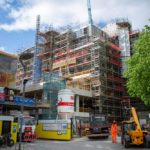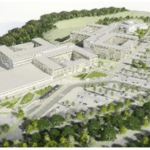News - Construction News
What does the NHS need from its buildings?

As the general election approaches, there are opportunities for parties to prioritise NHS infrastructure, says Nathalie Meunier, sales director of the permanent division at offsite manufacturer, Premier Modular. This is absolutely crucial, given that more than 2,000 NHS buildings outdate the organisation itself. But what does the health service need from new healthcare buildings and how can they be designed and built to meet future needs?

Nathalie Meunier
Whilst the condition of NHS estates varies between trusts, many hospitals and other healthcare buildings are outdated, with 42 per cent of the estate constructed before 1985. Others built much later have also outlived their initial purpose. Due to time and cost pressures, NHS trusts have been forced to take a reactive rather than proactive approach to updating their building stock – often making quick adaptations to old buildings.
To ensure fast-evolving services, such as cancer care, can be accommodated in future, the introduction of more flexible facilities is essential. For example, pathways for diagnosing and treating cancer have progressed well beyond what they were even a decade ago and need environments that can be easily adjusted to suit changes to service delivery – be that the installation of new equipment or the expansion of ward capacity.
Healthcare building designs therefore need to consider how internal space can be reconfigured to suit new demands, which might include positioning plant rooms and space used for managing building operations around the building’s circumference. Having medical-focused areas in the building’s heart could make space reconfiguration somewhat easier, without the need to navigate technical areas.
Such reconfiguration can be readily achieved where modern methods of construction (MMC) are used. For example, volumetric and panelised construction allow buildings to be restructured after projects are completed, such as adding or removing floors and walls. This is the case for permanent building solutions too, providing NHS trusts with long-term facilities that can be modified and scaled up or down to satisfy fluctuations in demand, or changes to service delivery.
As a faster method of building that minimises disturbance to critical services, such as emergency transportation, factory-based construction can deliver precious time savings to the NHS too. MMC practices significantly shorten the timescales of on site activities which are often limited to installation, internal fit outs and groundworks. To this end, the inclusion of MMC in the government’s new hospital programme is expected to make hospital construction 25 per cent cheaper and 20 per cent faster.
It follows that the delivery of more flexible, future-proofed healthcare buildings will require close collaboration between NHS trusts and suppliers to better inform the design process. The use of building information modelling (BIM) will play a vital role in this as the ability to share project data with third parties using BIM technology has made it far easier for all stakeholders to collaborate on BIM drawings, documents and models. In turn, this will help to ensure buildings are designed and built to the exact needs of the given trust. BIM can also be used to carry out predictive maintenance to assess and extend the lifespan of a building’s components to better manage interruptions to healthcare services in future.
Given that every NHS trust faces a unique set of demands and challenges, building projects must be approached on a case-by-case basis to ensure they are designed to meet specific needs.
The NHS is at a crossroads and in urgent need of facilities that stand the test of time. The flexibility and specificity of its next generation of buildings will be pivotal to its long-term success.
Nathalie Meunier is the sales director of the permanent division at offsite manufacturer, Premier Modular. She specialises in the health sector.
If you would like to read more stories like this, then please click here
Related Articles
More News
- Reforms to Building Safety Regulator to accelerate housebuilding
15 Jul 25
Delays to building new high-rise homes will be unblocked through a new package of reforms
- New £39Bn Social and Affordable Homes Programme
14 Jul 25
Hundreds of thousands of social and affordable homes, including 60% for social rent.
- UK Introduces New Trade Measures to Support Steel Sector
11 Jul 25
Steel producers across the UK will benefit from stronger trade measures from 1 July.






